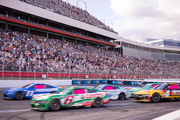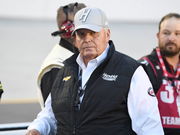
Imago
NASCAR, Motorsport, USA Cup Practice Nov 4, 2022 Avondale, Arizona, USA NASCAR chief operating officer Steve O Donnell speak to the media prior to practice for the NASCAR championship race at Phoenix Raceway. Avondale Phoenix Raceway Arizona USA, EDITORIAL USE ONLY PUBLICATIONxINxGERxSUIxAUTxONLY Copyright: xMarkxJ.xRebilasx 20221104_mjr_su5_041

Imago
NASCAR, Motorsport, USA Cup Practice Nov 4, 2022 Avondale, Arizona, USA NASCAR chief operating officer Steve O Donnell speak to the media prior to practice for the NASCAR championship race at Phoenix Raceway. Avondale Phoenix Raceway Arizona USA, EDITORIAL USE ONLY PUBLICATIONxINxGERxSUIxAUTxONLY Copyright: xMarkxJ.xRebilasx 20221104_mjr_su5_041
NASCAR finds itself navigating a finely tuned path between embracing bold, modern venues and honoring the sport’s cherished heritage. The calendar for this year shows a conscious attempt to both revive historic short tracks that contributed to the origins of stock car racing and excite fans with street events in global and urban environments. The conflict and synergy between innovation and tradition are highlighted by this two-pronged approach.
Watch What’s Trending Now!
NASCAR executive Steve O’Donnell’s understanding is that striking a balance between tradition and development is not merely symbolic, but strategic. He admits that NASCAR fans anticipate seeing the race at both historic short tracks and prestigious, transient locations in big economies.
ADVERTISEMENT
Revisiting the roots for the fans with a comeback
In a one-on-one interview with Eric Estepp for the Out of the Groove podcast, O’Donnell stressed that although historic venues should be maintained over time, accepting flaws is part of the appeal if supporters and sponsors recognize that venues like Darlington, Bowman Gray, or Rockingham deliver a distinct but equally genuine experience than contemporary speedways. “It is because you look at it with team ownership, right? As you talk to some folks, I’ve heard one owner say, ‘Why are you in Darlington? ’ which to me is crazy, right? Of course, we would be in Darlington, and we got destroyed when we left Darlington with one race, right? And we learned a lot. But that’s a balance of looking at where you’re going to be, what fans expect at certain racetracks,” he said.
Following the 2004 season, Darlington lost its spring race when NASCAR moved the dates to larger markets. Since Darlington’s Southern 500 history and distinctive track design made it one of the sport’s crown jewels, the move infuriated fans, due to which television ratings and attendance for its substitutes never lived up to expectations. The cost of the backlash was high; according to O’Donnell, NASCAR was “destroyed” by the loss of reputation and tradition. The error was eventually fixed in 2020 when Darlington was granted a second Cup date again, which was reinforced during the pandemic when it held several races. NASCAR executives agreed that the lesson was that historic racetracks like Darlington cannot be viewed as replaceable; market expansion needs to be balanced with a respect for the sport’s history.
“I think it’s on us that if you’re going to be at a track for the long term, make sure you’re investing in that facility. But also looking at some of the challenges around racetracks. If you only have one event other than stick and ball sports, right? Where you’ve got 16 to 165 races. We are trying to embrace what we can do around temporary things and temporary structures, bring in some concerts, bring in some different things,” O’Donnell said.
ADVERTISEMENT
His remarks are indicative of a larger plan: making sure that every location, whether new or old, has a distinct value proposition, whether it be through metropolitan dazzle or grungy nostalgia. The 2025 NASCAR schedule saw a notable return to legendary locations. This season’s exhibition race, the Cook Out Clash, moved to Bowman Gray Stadium. This marked the first Cup event to be staged at Winston-Salem’s famous quarter-mile “Madhouse” since 1971. High drama was given by Chase Elliott, who won the race by dominating 171 of 200 laps. “That’s the balance for us, maybe around some of our older facilities, or if you wanted to go back to a short track, it doesn’t have to be perfect. Just make sure that your sponsors understand that,” he added.
In the meantime, Rockingham Speedway, which has not been included on national series calendars since 2004 and 2013, respectively, saw a strong comeback from the Xfinity and Craftsman Truck Series. In front of an enthusiastic audience, Tyler Ankrum finally won the Truck Series race, securing a long-awaited victory. NASCAR’s dedication to honoring the past and promoting racing customs that continue to have a strong cultural resonance is demonstrated by these comebacks.
ADVERTISEMENT
Top Stories
New Charter Deal Triggers ‘Financial Frenzy’ as NASCAR Teams Set for Massive Payday

Rick Hendrick Strikes Fear in NASCAR Fans With Chevy’s New “Illegal” Car

Major Blow to Trackhouse Racing as Team Penske Steals Veteran Crew Chief Back in Unexpected Move

Chevy Team to Enter Kyle Larson’s Series as Michael Jordan Ends NASCAR’s Monopoly

Martin Truex Jr’s Former Crew Chief Ends 12-Year Fight In Huge Personal Announcement

NASCAR ventures into new territories with street races and global ambitions
With the revival of historic racetracks, NASCAR is aggressively growing its presence. In 2025, the Cup Series crossed international borders for the first time with its first points-earned race in Mexico City, contested at the Autódromo Hermanos Rodríguez.
While speaking to Sports Business Journal in April 2025, O’Donnell explained how he is keen to expand the sport: “We want to embrace our roots. So, I think you’ll see us do some more around some local short tracks, like we did at Bowman Gray. But then go to some big markets and some big cities. We don’t have a lot of those opportunities, so we want to do them right. Chicago Street’s been awesome, and Mexico City this year is going to be fantastic. And then there’s a lot of work that Ben Kennedy is doing around where we could kind of evolve that next story and look for some partnerships in some new cities as well,” he said.
ADVERTISEMENT
There are also talks going on to look into more showcase events in the city. Steve O’Donnell points to the LA Coliseum Clash and the Chicago street race’s triumphs as proof that NASCAR can adapt to urban settings with ease. The 2026 schedule looks to continue this trend, with NASCAR’s first race on an active military station taking place at Naval Station Coronado in San Diego and Chicagoland Speedway returning for a Cup points race. “We have a lot of work to do. I think the good news is we already have a little bit of a playbook from Chicago over the past few years. And you know, I think it’s going to be an incredible event for that part of the season,” said Ben Kennedy in August 2025.
This year’s Chicago Playbook will take place at a classic 1.5-mile track in Joliet, Illinois, which hosted the Cup Series from 2001 to 2019, replacing the downtown venue of the previous three seasons. With the possibility of the metropolitan event returning to Grant Park in the future, the event will continue to take place over the Independence Day weekend of July 4-5, which will help NASCAR maintain a presence in the Midwest market.
A calculated execution can be seen in NASCAR’s 2025 and 2026 calendars, which revive popular tracks like Bowman Gray and Rockingham while expanding into foreign and urban markets like Mexico City and San Diego. Steve O’Donnell’s approach acknowledges that maintaining the sport’s history and expanding its possibilities don’t have to conflict; rather, they create a narrative that enhances NASCAR’s appeal to a wider range of fans.
ADVERTISEMENT
ADVERTISEMENT
ADVERTISEMENT
ADVERTISEMENT

